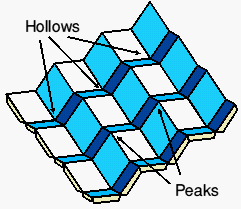
1 at the top lying in a set of
4 which sit in a set of
9.

1 at the top lying in a set of
3 which sit in a set of
6.

1 at the top lying in a set of
4 which sit in a set of
9.
How does this differ from the two-fold arrangement above?
To make this model you will need:
This model fills space, click here for an explanation of space filling polyhedra.
 |
This picture shows a stack of rhombic dodecahedra.
They close-pack, i.e. they fit together with no gaps between them; here they
are arranged to show how they fit in twos: 1 at the top lying in a set of 4 which sit in a set of 9. |
 |
This picture shows the same rhombic dodecahedra but they are arranged
to show how they fit in threes: 1 at the top lying in a set of 3 which sit in a set of 6. |
 |
This picture shows the same rhombic dodecahedra but here they are arranged
to show how they fit in fours: 1 at the top lying in a set of 4 which sit in a set of 9. How does this differ from the two-fold arrangement above? |
 |
Your model should look like this just before gluing face 9 to face 7 with tab i. The inside is coloured yellow and the tabs white. |
 |
Here is your finished model. This figure shows a 3-fold and a 4-fold symmetry axis. Which is which? |
 |
There are 6 hollows with 3 faces each, 3 cross-over points with 6 faces each and a peak in the middle with 3 faces. |
 |
There are 9 hollows with 4 faces each, 10 cross-over points with 4 faces and 4 peaks with 4 faces. |